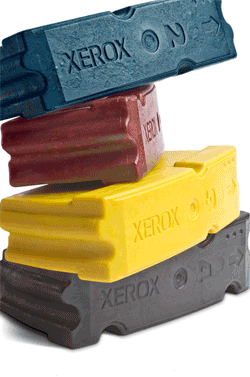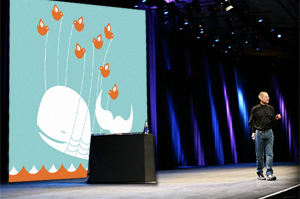 At $23,500, I’m reasonably sure Xerox’s new ColorQube 9200 multifunction printer is the most expensive product I’ve written about on Technologizer–but trust me, it’s neat. This “hallway” device for use by large groups of users for printing, copying, and scanning (it pumps out up to 85 pages a minute) competes with high-end color lasers, but uses Xerox’s unique solid-ink technology–which has meaningful advantages over laser when it comes to simplicity, cost of printing, and environmental impact.
At $23,500, I’m reasonably sure Xerox’s new ColorQube 9200 multifunction printer is the most expensive product I’ve written about on Technologizer–but trust me, it’s neat. This “hallway” device for use by large groups of users for printing, copying, and scanning (it pumps out up to 85 pages a minute) competes with high-end color lasers, but uses Xerox’s unique solid-ink technology–which has meaningful advantages over laser when it comes to simplicity, cost of printing, and environmental impact.
Solid ink is nothing new–it’s been around since 1991, and originated in Tektronix’s Phaser printers, a line later acquired by Xerox. But this is the first time that Xerox has scaled the technology up from desktop and workgroup printers to print at higher speeds and in greater volume. The basic idea’s the same: The ColorQube uses crayon-like sticks of ink which it melts and sprays onto a drum, then transfers onto paper. The ink sticks are relatively compact for the amount of pages they can produce (the ColorQube can run for 55,000 pages before you need to replenish ink). And you can just pop them into the printer as it’s convenient to do so–there are no toner cartridges to try and use until every speck of toner has been squeezed out.
Xerox says that solid ink is kinder to the planet than laser: Over four years of use, the ColorQube’s consumables will involve 88 pounds of packaging waste, vs. 815 pounds for a comparable color laser printer. The company even points out that the compactness of the color ink sticks means that it doesn’t need to send as many trucks out onto the road to deliver consumables for the ColorQube.
The printer’s other major news involves a hot-button issue with color printing: cost. Companies that lease color printers often pay by the page: a penny for black and white printing and eight cents for color is typical. The Xerox printer’s cost for pages with lots of full color will remain eight cents, but pages with less color will cost about three cents–and ones with just a splash of color will cost a penny. The idea is to get companies worrying less about color being too pricey and letting employees pump out Word documents, spreadsheets, and the like without increasing the per-page cost by 800 percent. We’ll see how it goes–every color-printer company has been working hard to make color more pervasive for years, but monochrome shows no signs of going away.
When it comes to print quality, solid ink’s pros and cons have historically been quite different from those of laser printer: the ink works well with a variety of media, but the output has sometimes been waxy-looking and duller than that of a good laser. However, Xerox provided me with some print samples from the ColorQube on various types of paper stock that looked quite pleasing.
This article is not, of course, a review or a recommendation–but after spending some time talking with Xerox staffers about the ColorQube, I do know that if I were in the market for a multifunction device in the class that it competes in, I’d want to check it out. The folks within business who acquire equipment like this tend to be a pretty conservative bunch, though, and it’ll be interesting to see if color ink’s real advantages versus laser prove enough to make this printer a hit.

 If you live in the Bay Area and are a FoT (Friend of Technologizer), read on: We’re throwing a party next Tuesday, May 12th from 5:30pm to 8:00pm at
If you live in the Bay Area and are a FoT (Friend of Technologizer), read on: We’re throwing a party next Tuesday, May 12th from 5:30pm to 8:00pm at  I’m moving to southeast England!
I’m moving to southeast England! At $23,500, I’m reasonably sure Xerox’s new
At $23,500, I’m reasonably sure Xerox’s new  Okay, so the chances of Apple buying Twitter seem nearly as remote as the odds that Twitter will buy Apple. It’s still fun to think about what might transpire if it did:
Okay, so the chances of Apple buying Twitter seem nearly as remote as the odds that Twitter will buy Apple. It’s still fun to think about what might transpire if it did: